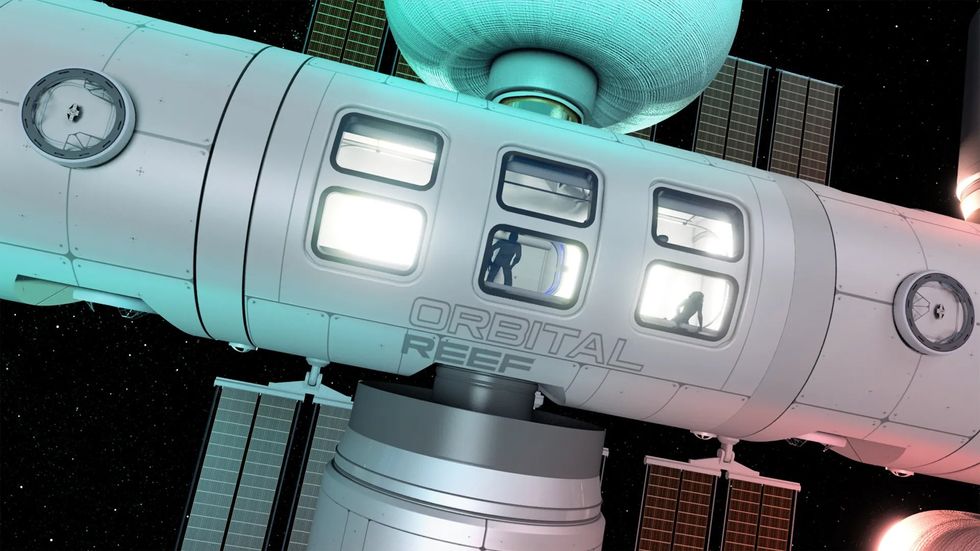A changing of the guard in space stations is on the horizon as private companies work toward providing new opportunities for science, commerce, and tourism in outer space.
Blue Origin is one of a number of private-sector actors aiming to harbor commercial activities in low Earth orbit (LEO) as the creaking and leaking International Space Station (ISS) approaches its drawdown. Partners in Blue Origin’s Orbital Reef program, including firms Redwire, Sierra Space, and Boeing, are each reporting progress in their respective components of the program. The collaboration itself may not be on such strong ground. Such endeavors may also end up slowed and controlled by regulation so far absent from many new, commercial areas of space.
Orbital Reef recently aced testing milestones for its critical life support system, with assistance from NASA. These included hitting targets for trace contaminant control, water contaminant oxidation, urine water recovery, and water tank tests—all of which are required to operate effectively and efficiently to enable finite resources to keep delicate human beings alive in orbit for long timeframes.
Blue Origin, founded by Jeff Bezos, is characteristically tight-lipped on its progress and challenges and declined to provide further comment on progress beyond NASA’s life-support press statement.
The initiative is backed by NASA’s Commercial LEO Destinations (CLD) program, through which the agency is providing funding to encourage the private sector to build space habitats. NASA may also be the main client starting out, although the wider goal is to foster a sustainable commercial presence in LEO.
The Space-Based Road Ahead
The challenge Orbital Reef faces is considerable: reimagining successful earthbound technologies—such as regenerative life-support systems, expandable habitats and 3D printing—but now in orbit, on a commercially viable platform. The technologies must also adhere to unforgiving constraints of getting mass and volume to space, and operating on a significantly reduced budget compared to earlier national space station programs.
Add to that autonomy and redundancy that so many mission-critical functions will demand, as well as high-bandwidth communications required to return data and allow streaming and connectivity for visitors.
In one recent step forward for Orbital Reef, Sierra Space, headquartered in Louisville, Colo., performed an Ultimate Burst Pressure (UBP) test on its architecture in January. This involved inflating, to the point of failure, the woven fabric pressure shell—including Vectran, a fabric that becomes rigid and stronger than steel when pressurized on orbit—for its Large Integrated Flexible Environment (LIFE) habitat. Sierra’s test reached 530,000 pascals (77 pounds per square inch) before it burst—marking a successful failure that far surpassed NASA’s recommended safety level of 419,200 Pa (60.8 psi).
Notably, the test article was 300 cubic meters in volume, or one-third the volume of ISS—a megaproject constructed by some 15 countries over more than 30 launches. LIFE will contain 10 crew cabins along with living, galley, and gym areas. This is expected to form part of the modular Orbital Reef complex. The company stated last year it aimed to launch a pathfinder version of LIFE around the end of 2026.
Inflating and Expanding Expectations
Whereas the size of ISS modules and those of China’s new, three-module Tiangong space station, constructed in 2021–22, was dependent on the size of the payload bay or fairing of the shuttle or rocket doing the launching, using expandable quarters allows Orbital Reef to offer habitable areas multiples (in this case five times) greater than the volume of the 5-meter rocket fairing to be used to transport the system to orbit.
Other modules will include Node, with an airlock and docking facilities, also developed by Sierra Space, as well as a spherical Core module developed by Blue Origin. Finally, Boeing is developing a research module, which will include a science cupola, akin to that on the ISS, external payload facilities, and a series of laboratories.
Orbital Reef will be relying on some technologies developed for and spun off from the ISS project, which was completed in 2011 at a cost of US $100 billion. The new station will be operating on fractions of such budgets, with Blue Origin awarded $130 million of a total $415.6 million given to three companies in 2021.
“NASA is using a two-phase strategy to, first, support the development of commercial destinations and, secondly, enable the agency to purchase services as one of many customers” says NASA spokesperson Anna Schneider, at NASA’s Johnson Space Center.
For instance, Northrop Grumman is working on its Persistent Platform to provide autonomous and robotic capabilities for commercial science and manufacturing capabilities in LEO.
Such initiatives could face politically constructed hurdles, however. Last year, some industry advocates opposed a White House proposal that would see new commercial space activities such as space stations regulated.
Meanwhile, the European Space Agency (ESA) signed a memorandum of understanding in late 2023 with Airbus and Voyager Space, headquartered in Denver, which would give ESA access to a planned Starlab space station after the ISS is transitioned out. That two-module orbital outpost will also be inflatable and is now expected to be launched in 2028.
China also is exploring opening its Tiangong station to commercial activities, including its own version of NASA’s commercial cargo and extending the station with new modules—and new competition for the world’s emerging space station sector.
>>> Read full article>>>
Copyright for syndicated content belongs to the linked Source : IEEE – https://spectrum.ieee.org/space-station-orbital-reef
